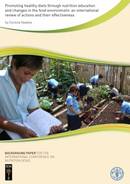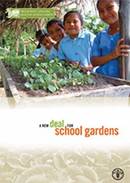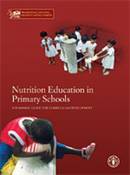Publications
According to the World Health Organization (WHO), of the 57 million global deaths in 2008, 36 million, or 63%, were due to non-communicable diseases (NCDs), principally ca rdiovascular diseases, diabetes, cancers and chronic respiratory diseases (WHO, 2011a). Nearly 80% of these deaths occur in low-and middle-income countries. Deaths from NCDs are projected to continue to rise worldwide, with the greatest increases expected in low- and middle-income regions.
School-age children need a good diet in order to develop and grow well, to study, to be protected from disease, and to have the energy to get through the day.
Some of today's biggest crisis points are nutrition, the environment, livelihoods and education. In all these areas, school gardens are making a proven contribution to children's wellbeing, understanding and life prospects. FAO's manual Setting up and running a school garden helps schools, governments and NGOs to establish gardens and to make them successful.
The Planning Guide consists of a technical reader, a set of worksheets and a classroom curriculum chart. This practical hands-on material provides background information on the aims of nutrition education in schools and gives step-by-step guidance in planning or redesigning a nutrition education classroom curriculum and related school-based nutrition actions. The material can be used at national or local level and is intended for use by a team of educators and health staff, including education inspectors, curriculum planners, teacher educators, teachers, nutritionists and health workers.
Le rapport sur l'état actuel des écoles durables en Amérique latine et dans les Caraïbes (édition 2021), élaboré dans le cadre du projet Consolidation des programmes d'alimentation scolaire en Amérique latine et dans les Caraïbes, rassemble un résumé des expériences de mise en œuvre de la méthodologie des écoles durables dans les pays de la région, en soulignant des aspects tels que les défis, la mise à l'échelle, les implications, l'expansion des programmes d'alimentation scolaire, les leçons apprises et les recommandations, dans le but de diffuser les bonnes pratiques.





